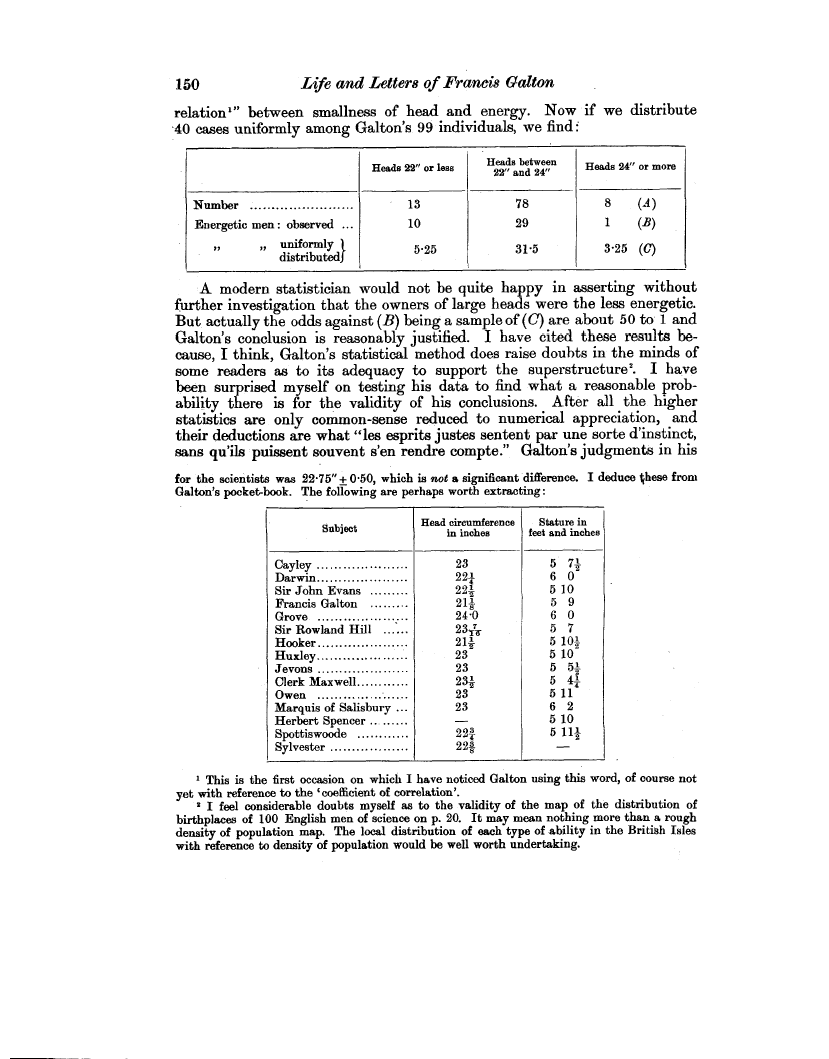150
Life and Letters of Francis Galton
relation"" between smallness of head and energy. Now if we distribute -40 cases uniformly among Galton's 99 individuals, we find
| |
Heads 22" or less |
Heads between
22' and 24 |
Heads 24" or more |
|
Number |
13 |
78 |
8 (A) |
|
Energetic men : observed ... |
10 |
29 |
1 (B) |
|
„ uniformly
distributed |
|
5.25 |
31.5 |
3.25 (C) |
A modern statistician would not be quite happy in asserting without further investigation that the owners of large heads were the less energetic. But actually the odds against (B) being a sample of (C) are about 50 to 1 and Galton's conclusion is reasonably justified. I have cited these results because, I think, Galton's statistical method does raise doubts in the minds of some readers as to its adequacy to support the superstructure'. I have been surprised myself on testing his data to find what a reasonable probability there is for the validity of his conclusions. After all the higher statistics axe only common-sense reduced to numerical appreciation, and their deductions are what "les esprits justes sentent par une sorte d'instinct, sans qu'ils puissent souvent s'en rendre compte. Galton's judgments in his
for the scientists was 22.75" + 0.50, which is not a significant difference. I deduce these from Galton's pocket-book. The following are perhaps worth extracting:
|
Subject
Subj |
Head circumference
in inches |
Stature in
feet and inches |
|
Cayley |
23 |
5 72 |
|
Darwin |
224 |
6 0 |
|
Sir John Evans |
221 |
5 10 |
|
Francis Galton |
218 |
5 9 |
|
Grove |
24.0 |
6 0 |
|
Sir Rowland Hill |
23 7 |
5 7 |
|
Hooker |
211 |
5 102 |
|
Huxley |
23 |
5 10 |
|
Jevons |
23 |
5 52 |
|
Clerk Maxwell |
232 |
5 44 |
|
Owen |
23 |
511 |
|
Marquis of Salisbury ... |
23 |
6 2 |
|
Herbert Spencer |
- |
5 10 |
|
Spottiswoode |
223 - |
5112 |
|
Sylvester |
223 |
- |
" This is the first occasion on which I have noticed Galton using this word, of course not yet with reference to the `coefficient of correlation'.
2 I feel considerable doubts myself as to the validity of the map of the distribution of birthplaces of 100 English men of science on p. 20. It may mean nothing more than a rough density of population map. The local distribution of each type of ability in the British Isles with reference to density of population would be well worth undertaking.

